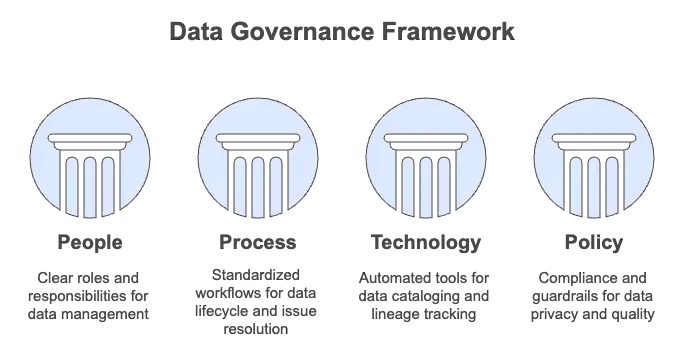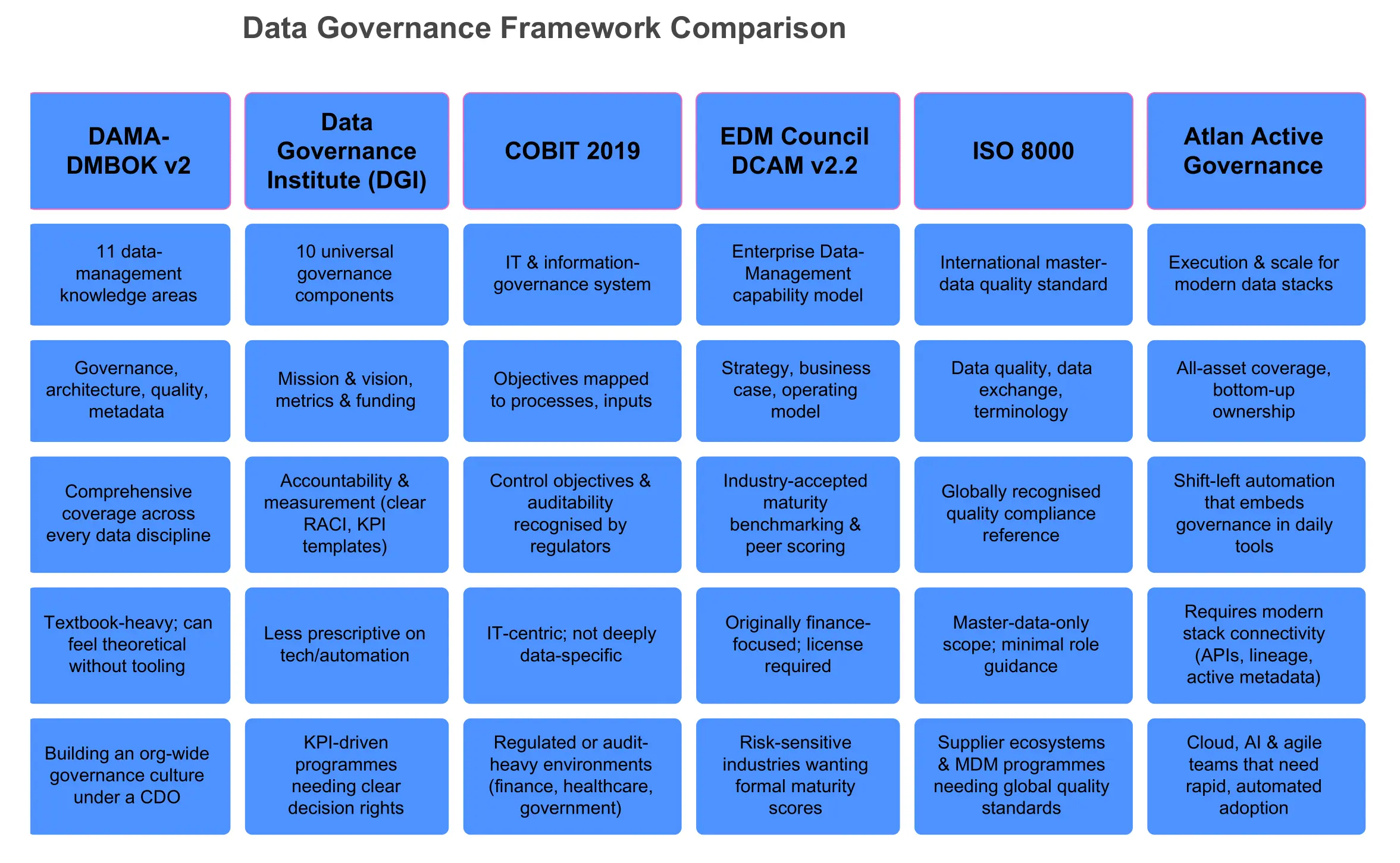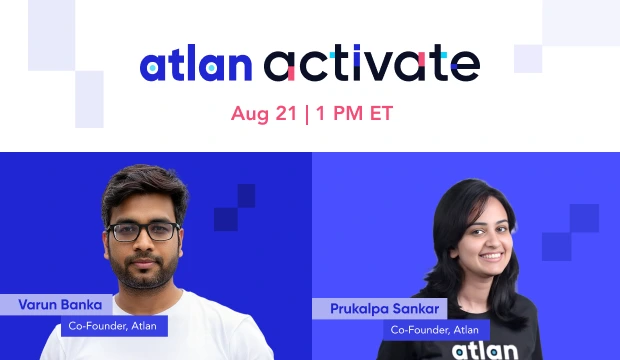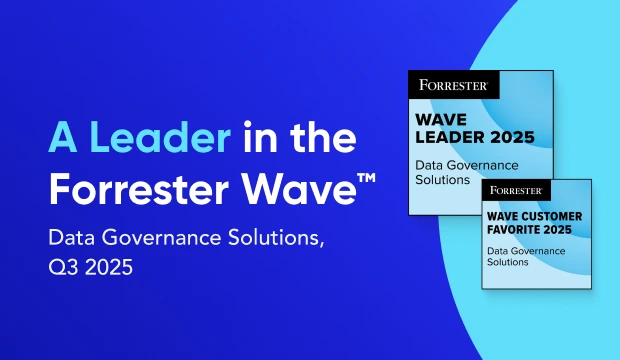Data governance framework explained #
Summarize and analyze this article with 👉 🔮 Google AI Mode or 💬 ChatGPT or 🔍 Perplexity or 🤖 Claude or 🐦 Grok (X) .
A data governance framework is a structured operating model that defines how an organization manages, secures, and utilizes its data assets for maximum business value and compliance.
Modern frameworks move beyond traditional, heavy documentation by creating operational guardrails that empower teams to deliver trusted data at scale, fostering both innovation and compliance. They serve as the critical link between data producers and consumers, transforming governance from a potential bottleneck into a business accelerator.
What are the pillars of a data governance framework? #
Modern frameworks revolve around four foundational pillars:
1. People - Ownership & accountability #
- Clear ownership: Every data asset (tables, dashboards, ML models) has documented owners and stewards
- Federated stewardship: Domain teams self-service while central teams set standards
- Metrics-driven responsibility: Steward mean-time-to-resolution (MTTR) tracked like incident response
- Role definitions: Data Governance Council, Data Quality Analysts, Data Stewards, and Data Architects with clear responsibilities
Beyond traditional roles, successful organizations are now implementing:
- Community-led governance committees with cross-functional representation
- Executive data sponsors who champion governance at leadership level
- AI ethics stewards who focus specifically on model governance
2. Process - Standardization & workflows #
- Lifecycle management: Checkpoints from creation → quality assurance → certification → archival
- Issue resolution: Automated workflows open tickets with lineage context when problems arise
- Continuous improvement: Policy reviews (typically quarterly) measured by trust score improvement
- Change management: Versioned policies with approval workflows and impact assessment
- Exception handling: Documented procedures for policy exceptions with appropriate approvals
3. Technology - Automation & intelligence #
- Unified cataloging: Auto-discovery spanning clouds, databases and BI tools
- Real-time lineage: Impact analysis shows upstream/downstream dependencies
- Event-driven controls: Automations that revoke access or alert when policies are breached
4. Policy - Compliance & guardrails #
- Machine-readable rules: Codified policies for privacy, quality and retention requirements
- Version control: Git-style tracking of policy changes with approvals
- Audit-ready logs: Complete history of policy evaluations and actions
- Regulatory mapping: Policies linked directly to compliance requirements
- Risk-based classification: Data categorized by sensitivity and business impact
The most effective frameworks integrate these pillars through three modern execution principles:
- All-asset coverage: Applying governance across every system and data type.
- Bottom-up practice: Encouraging data producers and stewards to tag assets as they work.
- In-workflow controls: Embedding governance directly into daily workflows, such as SQL editors and BI tools.

Pillars of a Data Governance Framework. Source: Atlan.
Why does a data governance framework matter in 2025? #
The stakes for proper governance have never been higher. Gartner estimates that 80% of digital business initiatives will stall this year because of poor governance. Here’s why having a robust framework matters:
- Regulatory compliance: GDPR, CCPA, HIPAA and industry-specific requirements demand demonstrable controls
- AI readiness: Clean, context-rich data is fundamental for training accurate and unbiased AI models
- Security posture: Proper classification and access controls reduce breach risk
- Decision quality: Executive dashboards must reconcile data from diverse sources
- Operational efficiency: Poorly governed data can lead to significant financial losses; for instance, one Fortune 500 company loses $2.9 million daily when misaligned dashboards disrupt supply chain decisions
- Technical debt reduction: Well-governed data environments reduce redundancy and streamline architecture
For different organizational roles, these challenges manifest uniquely:
- For CDOs: Balancing innovation enablement with compliance requirements
- For Governance Heads: Scaling oversight as data volumes explode
- For Data Platform Teams: Automating controls without creating bottlenecks
- For Compliance Officers: Maintaining evidence of control effectiveness
The explosion of data sources, cloud migrations, and AI adoption in 2025 have made traditional approaches insufficient. Organizations need frameworks that balance control with agility.
How to implement a data governance framework? #
A robust data governance framework isn’t built from a lengthy manual. Instead, it begins with five agile, high-impact steps:
1. Define outcomes & link to business goals #
- Map company OKRs to specific data quality/compliance goals
- Identify critical data domains that drive key business processes
- Define measurable success metrics (e.g., policy compliance rates, issue resolution time)
Actionable tip: Create a governance value map that explicitly connects data quality improvements to business KPIs. For example: “5% improvement in customer data accuracy → 3% reduction in failed marketing campaigns → $X additional revenue.”
2. Inventory assets & assign ownership #
- Auto-discover data assets across your ecosystem using metadata crawlers
- Tag owners and stewards for each significant data domain using RACI matrices
- Start with high-value/high-risk data (customer PII, financial data, ML training sets)
- Document asset relationships through automated lineage mapping
- Establish clear escalation paths for orphaned or disputed assets
Actionable tip: For large organizations, use a “tiered governance” approach. Identify crown jewel data assets (Tier 1) for full governance, with lighter controls for other tiers.
3. Draft baseline policies #
- Create foundational rules for data quality, access, retention, and privacy.
- Define data classification levels (e.g., public, internal, confidential).
- Document specific standards by domain, such as for revenue, marketing, or machine learning datasets
Actionable tip: Write policies as code from day one to enable automation—for example, SQL queries that validate quality rules or PII detection patterns.
4. Automate enforcement #
- Utilize data lineage to precisely scope and apply policies.
- Configure workflows to automatically trigger alerts, revoke access, or apply specific tags based on policy rules.
- Enable self-service access to data, incorporating necessary approval workflows.
Actionable tip: Create a governance “control tower” that visualizes policy compliance across domains, alerting on emerging issues before they become critical.
5. Measure & iterate #
- Continuously monitor data freshness, usage patterns, and issue Mean Time to Resolution (MTTR).
- Report compliance and coverage metrics to executives.
- Iterate on the framework quarterly, incorporating stakeholder feedback and audit results for continuous improvement.
Actionable tip: Implement a simple governance maturity model (1-5 scale) for each domain, celebrating improvements and identifying focus areas for the next quarter.
What are popular governance frameworks and how do they compare? #

Data Governance Framework Comparison. Source: Atlan.
While each model is valid, their execution is evolving:
- DAMA and DGI provide structural definitions, whereas Atlan focuses on enabling large-scale adoption.
- DCAM helps measure maturity, while Atlan automates the process of achieving it.
- ISO and COBIT require evidence, and Atlan automatically generates the necessary audit trails.
Let’s explore a few of these in more detail:
DAMA-DMBOK #
The DAMA framework places data governance at the center of a wheel surrounded by nine knowledge areas. Its strength lies in comprehensively mapping the relationships between data governance and other data management practices like:
- Data architecture management
- Data quality management
- Metadata management
- Data security management
DAMA-DMBOK is excellent for organizations building a comprehensive data management practice but can be process-heavy for teams seeking agility.
DGI (Data Governance Institute) #
The DGI framework centers around ten universal components that address the why-what-who-how of data governance:
- Mission and vision
- Goals, metrics, and funding
- Data rules and definitions
- Decision rights
- Accountabilities
- Controls
- Data stakeholders
- Data governance office
- Data stewards
- Data governance processes
DGI excels at creating clear accountability structures and measurement systems.
Atlan Active Governance #
Atlan’s framework represents the modern shift toward practical, automation-first governance. It emphasizes:
- Automated curation and enforcement through active metadata
- Collaborative processes that engage both technical and business stakeholders
- Extensible architecture that adapts to evolving requirements
- Bottom-up adoption rather than top-down mandates
This approach is particularly well-suited for organizations undergoing cloud transformation or building AI capabilities.
What challenges do modern frameworks solve? #
Modern data governance frameworks are designed to address common pain points:
Challenge 1: Manual documentation becomes outdated immediately #
Impact by role:
- For CDOs: Diminished trust in governance artifacts
- For Data Platform Teams: Wasted engineering hours maintaining documentation
- For Data Consumers: Difficulty finding reliable information
Solution: Active metadata platforms that automatically update documentation when schemas change, dashboards are modified, or lineage shifts. This “shift left” approach moves governance closer to where data is created.
Challenge 2: Siloed governance tools separate from daily workflows #
Impact by role:
- For Governance Heads: Low adoption of governance standards
- For Data Teams: Governance feels like extra work rather than value-add
- For Business Users: Friction accessing governed data
Solution: In-workflow governance that embeds controls, documentation and quality checks within the tools data producers and consumers already use (BI platforms, data catalogs, SQL editors).
Challenge 3: Centralized teams can’t scale with data volume #
Impact by role:
- For Governance Teams: Overwhelming backlog of assets to govern
- For Domain Experts: Slow response to governance requests
- For Compliance Officers: Incomplete coverage of critical assets
Solution: Domain-based ownership with federated stewardship models where subject matter experts maintain their own domains while central teams set standards.
Challenge 4: Static policies can’t adapt to dynamic environments #
Impact by role:
- For CDOs: Governance becomes a blocker to innovation
- For Cloud Teams: Governance lags behind infrastructure changes
- For Data Scientists: AI initiatives face governance hurdles
Solution: Rule-based automation using lineage to intelligently apply policies as data environments evolve. For example, automatically tagging PII as it’s detected across new sources.
What does success look like? (Customer stories) #

Modernized data stack and launched new products faster while safeguarding sensitive data
“Austin Capital Bank has embraced Atlan as their Active Metadata Management solution to modernize their data stack and enhance data governance. Ian Bass, Head of Data & Analytics, highlighted, ‘We needed a tool for data governance… an interface built on top of Snowflake to easily see who has access to what.’ With Atlan, they launched new products with unprecedented speed while ensuring sensitive data is protected through advanced masking policies.”

Ian Bass, Head of Data & Analytics
Austin Capital Bank
🎧 Listen to podcast: Austin Capital Bank From Data Chaos to Data Confidence

53 % less engineering workload and 20 % higher data-user satisfaction
“Kiwi.com has transformed its data governance by consolidating thousands of data assets into 58 discoverable data products using Atlan. ‘Atlan reduced our central engineering workload by 53 % and improved data user satisfaction by 20 %,’ Kiwi.com shared. Atlan’s intuitive interface streamlines access to essential information like ownership, contracts, and data quality issues, driving efficient governance across teams.”
Data Team
Kiwi.com
🎧 Listen to podcast: How Kiwi.com Unified Its Stack with Atlan

One trusted home for every KPI and dashboard
“Contentsquare relies on Atlan to power its data governance and support Business Intelligence efforts. Otavio Leite Bastos, Global Data Governance Lead, explained, ‘Atlan is the home for every KPI and dashboard, making data simple and trustworthy.’ With Atlan’s integration with Monte Carlo, Contentsquare has improved data quality communication across stakeholders, ensuring effective governance across their entire data estate.”

Otavio Leite Bastos, Global Data Governance Lead
Contentsquare
🎧 Listen to podcast: Contentsquare’s Data Renaissance with Atlan
Ready to build your data governance framework? #
Data governance is not just about control. It is how modern teams build trust in their data, decisions, and business.
Whether you are just getting started or scaling fast, the right framework can turn intent into impact.
Let us help you build it
Book a Personalized Demo →FAQs on data governance framework #
How do I implement a data governance framework? #
To implement a data governance framework, start by defining your organization’s data goals and identifying stakeholders. Establish clear policies for data usage, assign roles and responsibilities, and implement tools for monitoring and maintaining data quality.
What’s the difference between governance and management? #
Governance defines policies, roles, and controls. Management operates the systems under those rules.
Who owns data governance? #
The CDO leads, but success depends on a federated model with domain stewards, central standards, and platform automation.
What tools are used for data governance framework implementation? #
Common tools include data catalogs, metadata management systems, and data quality monitoring tools. These tools help automate governance tasks, track data lineage, and ensure compliance.
How do I measure data governance ROI? #
- Fewer fines & audit penalties
- Reduced time to access data
- Better trust in dashboards & models
- Faster product launch & feature delivery
How can a data governance framework ensure compliance with regulations? #
A governance framework provides structured processes for monitoring data usage and enforcing regulatory compliance. This includes audit trails, access controls, and regular compliance checks.
What’s the AI impact on governance? #
- Lineage to detect bias and drift
- Controls on training data quality
- Model auditability for fairness and regulation
How does this relate to data mesh? #
Data mesh depends on clear governance: domain ownership, self-service policies, and shared definitions across domains.














